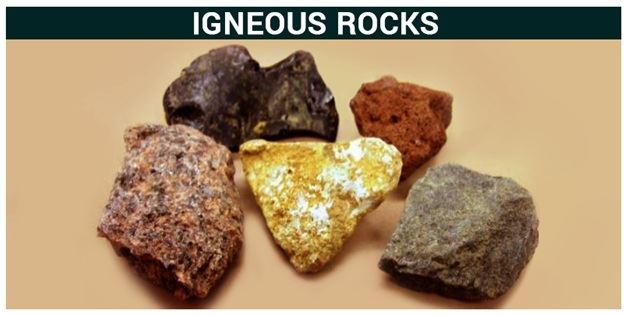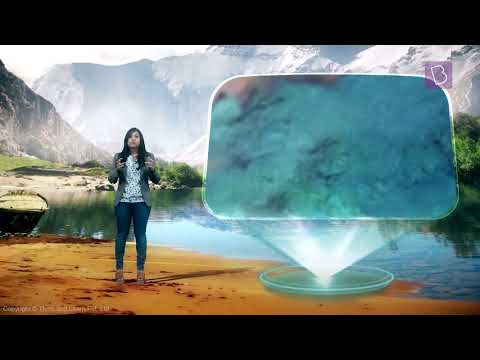Rocks are formed naturally when the tiny grains of different minerals get compressed due to the pressure exerted on them. The rock formation process is different for different types of rocks. Sedimentary rocks are formed by the accumulation or deposition of mineral or organic particles at the Earth’s surface while metamorphic rocks are formed when watery hot fluids are subjected to high heat and pressure, lastly, igneous rocks are formed when lava cools and solidifies. In this article, let us understand igneous rocks and their formation in detail.
What are Igneous Rocks?
Igneous rocks are defined as types of rocks that are formed when molten rock (rock liquefied by intense heat and pressure) cools to a solid state.

Lava is molten rock flowing out of fissures or vents at volcanic centres (when cooled they form rocks such as basalt, rhyolite, or obsidian). Pyroclastic deposits are accumulations of fragmented material (e.g. ash, bombs, tuffs, and volcanic breccias) ejected during volcanic eruptions. As igneous rocks are formed from magma and begin the rock cycle, they are called primary rocks.
Igneous rocks can be easily identified with their texture, density, colour, and mineral composition. Its texture depends on the shape, size, time period to cool down and solidify, and the arrangement of crystals in the rock.
Interested to learn more about other types of rocks, below are the links:
Igneous rock texture
The texture is a description of a rock’s constituent parts in terms of their sizes, shapes and arrangement
Rule of Thumb
The size of mineral crystals in an igneous rock may indicate the rate at which the lava or magma cooled to form a rock. Crystal size can also be affected by the number of gases or the availability of the chemicals in the molten rock that are required to form the crystals.
Larger crystals generally indicate intrusive igneous rocks. Smaller crystals generally indicate faster cooling associated with extrusive igneous rocks.
| Types of Igneous Rock Texture |
|
With the help of colourful visualisations learn the formation of rocks by watching the video.

Characteristics of Igneous Rocks
- The igneous form of rocks does not include any fossil deposits. If there are any chances of fossil deep inside the crust, it erupts out of the Earth’s surface and gets destroyed due to the sheer heat these rocks produce.
- Most igneous forms include more than one mineral deposit.
- They can be either glassy or coarse.
- These usually do not react with acids.
- The mineral deposits are available in the form of patches with different sizes.
Types of Igneous Rocks
Igneous rocks can look different based on the cooling conditions and they can have different compositions based on the lava they cool from. The main two categories of igneous rocks are known as extrusive and intrusive rocks.
Intrusive Igneous Rock
Intrusive igneous rocks are rocks that crystallize below the earth’s surface resulting in large crystals as the cooling takes place slowly. Diorite, granite, pegmatite are examples of intrusive igneous rocks.
Extrusive Igneous Rock
Extrusive igneous rocks are rocks that erupt onto the surface resulting in small crystals as the cooling takes place quickly. The cooling rate for a few rocks is so quick that they form an amorphous glass. Basalt, tuff, pumice are examples of extrusive igneous rock.
For More Information Igneous Rocks And Its Types, Watch The Below Video:

Igneous Rocks Examples
In this section, we will discuss the various examples of igneous rocks and their uses.
Granite
Granite is a hard igneous rock made of clearly visible crystals of various minerals. Granites are used for buildings and houses, especially in the kitchen and bathroom.
Basalt
Basalt is a dark-coloured, fine-grained igneous rock. Basalt is one of the main rocks that are prevalent in the oceanic crust. As basalt is rich in iron so it is used as an ingredient of concrete. Basalt is the most common type of igneous rock.
Pumice
Pumice is a light igneous rock with thousands of tiny bubbles in them. They are used to remove dead skin from the bottom of their feet. It is used in abrasive cleaning products.
Other examples of igneous rocks along with their features are listed below in the table:
|
Rock Name |
Colour |
Texture |
|
Diorite |
medium coloured |
course |
|
Rhyolite |
light coloured (pastel) |
pastel |
|
Obsidian |
dark coloured |
glass |
|
Tuff |
fine-grained ash |
ash particles |
Frequently Asked Questions – FAQs
Why are igneous rocks called primary rocks?
Which is the most common type of igneous rock?
Which igneous rocks are intrusive?
Which igneous rocks are extrusive?
Which igneous rock is porous?
Stay tuned to BYJU’S and Fall in Love with Learning!


Interesting lecture video